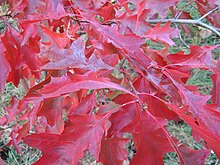Scarlet oak
| Scarlet oak | ||||||||||||
|---|---|---|---|---|---|---|---|---|---|---|---|---|

Scarlet oak ( Quercus coccinea ) |
||||||||||||
| Systematics | ||||||||||||
|
||||||||||||
| Scientific name | ||||||||||||
| Quercus coccinea | ||||||||||||
| Münchh. |
The scarlet oak ( Quercus coccinea ) is a deciduous tree from the genus of oaks ( Quercus ) in the beech family (Fagaceae). It is the official tree of the US Federal District of Columbia .
description
The scarlet oak is a deciduous tree . It can reach a height of 20 to 25 meters. The crown of young trees is still tightly conical, with increasing age it becomes more irregular and somewhat loose. The bark of the trunk is silver-gray and smooth when young; later it becomes dark gray and fine cracked with many warts.
The young twigs are orange-brown, often more red-brown on the top and more olive-colored on the underside. The buds are pointed ovoid with dark red-brown scales. The alternate leaves of the scarlet oak are variable in shape and size. They are 7 to 17 cm long, 8 to 13 cm wide and deeply lobed. The leaf is not hairy and sits on a thin stalk about 2.5 to 3 cm long. The scarlet autumn color, which usually sets in prematurely on one or two individual branches, is very striking. Some of the leaves on the lower branches often stay on the tree until January.
The scarlet oak is monoecious ( monoecious ). The male flowers sit in pendulous catkins . The acorns are egg-shaped and about 1 to 2 cm long; they sit in a flat, broad-scaled cup.
Distribution and location
This tree species is native to the east of North America . The range extends from Maine in the north to Oklahoma in the west and Alabama in the south. It is also native to the extreme south of Ontario (Canada). The scarlet oak was introduced in Europe as an ornamental and park tree. The scarlet oak (Berlin-Altglienicke) is known .
The scarlet oak grows in dry, sandy and acidic soils.
Systematics
The first description of the species was published in 1770. It comes from the six-volume work Der Hausvater of the German botanist Otto Freiherr von Münchhausen .
Cultivated forms
- 'Splendens': This large-leaved form has glossy leaves about 18 × 13 cm; the petioles are 4 to 6 cm long and longer than the type. The shape has an even more intense, bright autumn color than the type.
Similar species
There is a risk of confusion with the red oak ( Q. rubra ), the swamp oak ( Q. palustris ) and the dyer's oak ( Q. velutina ).
Sources and further information
Individual evidence
- ↑ http://www.usna.usda.gov/Gardens/collections/statetrees.html#scarletoak
- ↑ The housefather 5: 254. 1770; see entry at GRIN Taxonomy for Plants .
literature
- Alan Mitchell, translated and edited by Gerd Krüssmann: The forest and park trees of Europe: An identification book for dendrologists and nature lovers . Paul Parey, Hamburg and Berlin 1975, ISBN 3-490-05918-2 .
- C. Frank Brockman: Trees of North America . St. Martin's Press, New York 2001, ISBN 978-1-58238-092-6 .
Web links
- Brief description at baumkunde.de
- Entry at USDA (Engl.)
- Description for Flori Data (Engl.)
- Description in trees.stanford.edu (Engl.)
- Data sheet at hort.uconn.edu (engl.)


